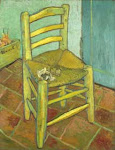Readers of “Sunflowers” will notice the occasional word/phrase in French sprinkled in for flavor, but also the occasional word/phrase in Provençal — a separate language that today is spoken by a minority but in van Gogh’s time was experiencing a virtual renaissance. Provençal is a dialect of the language termed Occitan by modern linguists and known in French as la langue d’oc. Gascon and Auvergnat are likewise dialects of Occitan, but there are many others throughout southern France, as well as parts of northern Italy, Monaco, and Spain. Historically there were two major languages in France: the langue d’oc (spoken in the south) and the langue d’oïl (spoken in the north). Both are Romance languages rooted in Latin and the Roman occupation of Gaul. In the sixteenth century, the Edict of Villers-Cotterets decreed that the Northern langue d’oïl should be used for all administration; modern French thus derives from one of the oïl dialects. In fact, the closest linguistic cousin of the southern Occitan language is not modern French, but Catalan! The Provençal dialect of Occitan is native to southeastern France, and within it are variant sub-dialects. Two of these are the Rodanenc or Rhodanien sub-dialect, found around the Rhône River in cities such as Nîmes, Arles, and Avignon; and the Maritim or Centrau sub-dialect, found in the area of Marseilles and Aix-en-Provence.
In van Gogh’s time, the Provençal language was gaining increased attention thanks to the efforts of writer Frédéric Mistral and the Félibrige movement he founded in 1854. The Félibriges sought to revive Provençal literature and culture after decades — even centuries — of oppression by the French government. During and after the French Revolution in particular, Occitan and its dialects were forbidden in all official capacities. Young boys and girls (like Rachel) growing up in Provence in the nineteenth century would have learned only French in school, although they most likely spoke Provençal at home. Mistral aimed to counteract these developments, as he and other authors published books and poems in Provençal and worked to revive traditional customs and dress. Under the direction of the Félibriges, new dictionaries and grammars of the Provençal language were created. In Arles, Mistral founded the Museon Arlaten — which still exists today as a celebration of traditional Provençal culture — and a statue of him stands prominently in the city.
Van Gogh was fluent in French but knew no Provençal upon arriving in Arles. He claimed in his letters to Theo that his deficiency in the language caused problems and that many Arlesiens could not understand him. He was aware of the Félibrige movement, however, and mentioned it in his letters, while in January 1889, he attended a performance of a traditional Provençal pastorale (Nativity play) in the native language. It is unclear whether Vincent learned any spoken Provençal during his two years in the south of France, although it’s likely he picked up a few words and phrases given his flair for languages. He did very much admire the traditional Arlésienne dress promoted by Mistral and his colleagues...more on the the lovely Arlésiennes another day!
Subscribe to:
Post Comments (Atom)






2 comments:
Interesting, for I didnt' realize that Provencal had a dialect so diverse that it could have been considred almost a language onto its own. I never thought of Vincent having this additional problem to bear when he moved there. Thanks for sharing this insight, you have expanded my knowledge base.
Hi Fredericks,
Thanks for stopping by and for commenting!
Post a Comment